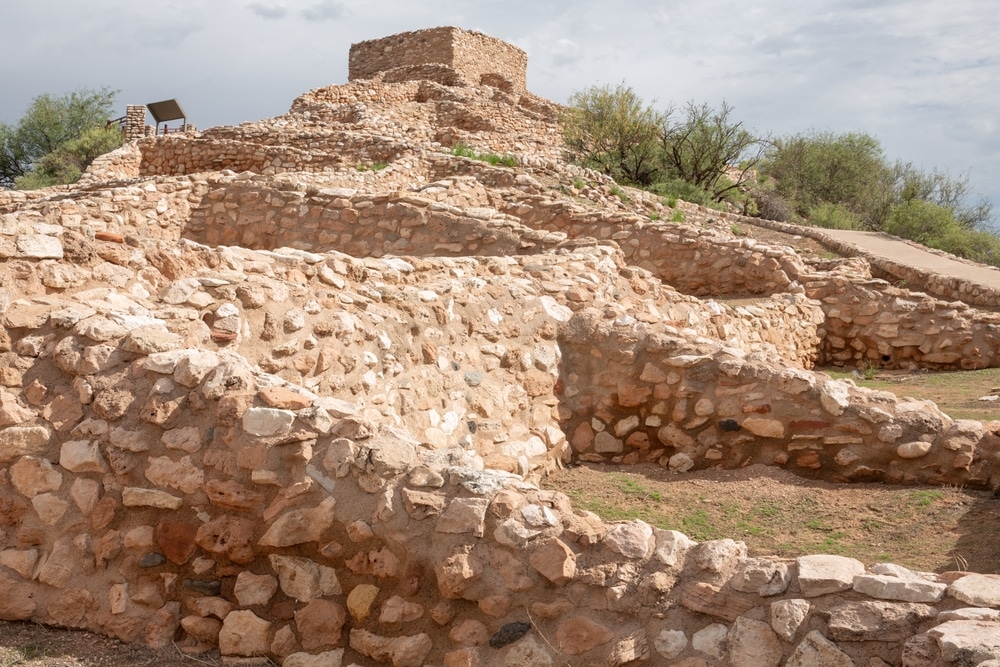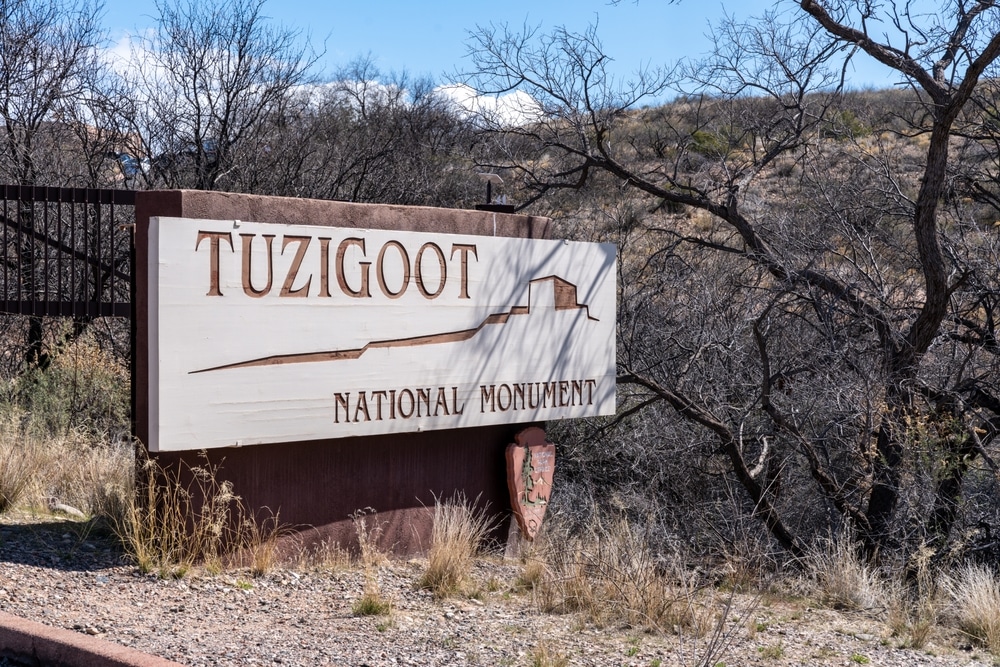Perched atop a limestone ridge in Arizona’s Verde Valley, Tuzigoot National Monument preserves the remarkable remains of a Sinagua pueblo that once thrived as a bustling hillside village. The name “Tuzigoot,” derived from an Apache word meaning “crooked water,” aptly describes the monument’s setting near the meandering Verde River. This 42-acre protected area offers visitors a unique opportunity to step back in time and explore one of the best-preserved prehistoric pueblos in the American Southwest.
Established as a national monument in 1939 following extensive excavation and restoration work during the Great Depression, Tuzigoot represents a significant archaeological treasure that illuminates the sophisticated agricultural society that flourished here between approximately 1000 and 1400 CE. The pueblo’s 110 rooms, including second-story structures and a central tower, stand as testament to the architectural prowess and community organization of the ancient Sinagua people.
Located just minutes from the historic mining town of Clarkdale and the artistic community of Jerome, Tuzigoot’s accessible location in central Arizona makes it an ideal destination for both casual visitors and serious students of Native American history. The monument’s setting amid the picturesque Verde Valley, with commanding views of the surrounding riparian landscape and distant mountains, adds natural beauty to its cultural significance, creating a multifaceted recreational and educational experience for all who visit.

The main attraction of the monument is the Tuzigoot Pueblo, a 110-room ancient structure built by the Sinagua people between 1125 and 1400 AD. Wander through the partially reconstructed ruins to see how the Sinagua used local materials to create their homes and community spaces. Climb to the top of the pueblo for panoramic views of the Verde Valley.
The monument’s visitor center houses an excellent museum with artifacts recovered from the site. These include pottery, tools, and jewelry that provide a glimpse into the daily lives of the Sinagua people. Interactive exhibits and displays explain the history, culture, and significance of the pueblo.
A paved trail loops around the pueblo, allowing visitors to explore the ruins at their own pace. Along the way, interpretive signs provide information about the architecture, agriculture, and lifestyle of the Sinagua people. The trail is relatively short and accessible for most visitors.

The Sinagua people were skilled farmers who made use of the Verde River and its fertile floodplains to grow crops such as corn, beans, and squash. Interpretive displays at the monument explain how the Sinagua adapted to their environment and thrived in the arid Southwest.

Perched on a hill overlooking the Verde River, Tuzigoot offers breathtaking views of the surrounding desert, river, and distant mountain ranges. Bring a camera to capture the stunning scenery, especially during sunrise or sunset.

For those who want to explore beyond the pueblo, the Tavasci Marsh Trail provides an easy hike to a lush wetland area. This trail offers a chance to spot wildlife, enjoy the shade of cottonwood trees, and experience a different side of the Verde Valley’s ecosystem.

Check the schedule for ranger-led programs such as guided tours, talks, and demonstrations. These programs provide deeper insights into the history, culture, and environment of Tuzigoot and the surrounding area.

The Tuzigoot area is a haven for birdwatchers, particularly near the Tavasci Marsh, a nearby wetland that is part of the Verde River Greenway. Look for herons, egrets, hawks, and other bird species that inhabit the area. Binoculars are highly recommended for bird enthusiasts.

Tuzigoot is located near other fascinating destinations, including Montezuma Castle National Monument, Jerome State Historic Park, and the Verde River Greenway. Plan a day trip to explore the rich cultural and natural heritage of the region.

Tuzigoot National Monument has a small picnic area where visitors can enjoy a meal while taking in views of the Verde Valley. It’s a peaceful spot to relax and reflect on the ancient history of the site.

| Category | Details |
|---|---|
| Location | Near Clarkdale, Arizona, USA |
| Established | July 25, 1939 |
| Managed By | National Park Service |
| Size | Approximately 42 acres (17 hectares) |
| Main Attractions | Tuzigoot Pueblo, museum exhibits |
| Cultural Significance | Preserves a large Sinagua pueblo (multi-room structure) built around 1000–1400 CE |
| Time Period | Pueblo dates from approximately 1125–1400 CE |
| Geology | Located in the Verde Valley, near the Verde River; features sedimentary formations |
| Ecosystem | Desert grassland with riparian zones near the Verde River |
| Nearby Landmarks | Montezuma Castle National Monument, Jerome State Historic Park |
| Visitor Activities | Walking trails, interpretive exhibits, birdwatching, photography |
| Climate | Hot summers, mild winters, with low annual rainfall |
| Entrance Fee | $10 per adult (children under 16 free; fees subject to change) |
| Accessibility | Visitor center and parts of the pueblo are wheelchair accessible |
| Fun Fact | “Tuzigoot” is an Apache word meaning “crooked water,” referring to nearby streams. |
The pueblo at Tuzigoot was built and inhabited by the Sinagua, a prehistoric cultural group that occupied the Verde Valley and neighboring regions from approximately 600 to 1400 CE. The name “Sinagua,” meaning “without water” in Spanish, was assigned by archaeologists to reference the people’s impressive ability to thrive in an arid environment through sophisticated agricultural and water management techniques.
The Sinagua were primarily farmers who cultivated corn, beans, and squash in the fertile soils along the Verde River. They supplemented their diet through hunting, gathering wild plants, and trading with other indigenous groups across a wide network that extended from the Pacific Coast to central Mexico. Evidence of these trade networks appears in artifacts found at Tuzigoot, including seashells, exotic minerals, and distinctive pottery styles originating from distant regions.
The pueblo at Tuzigoot represents the Sinagua culture at its peak development. Archaeological evidence suggests that the settlement began as a small cluster of rooms around 1000 CE and gradually expanded over centuries as the population grew and prosperity increased. At its height around 1300 CE, the pueblo housed approximately 200-250 people in a complex of interconnected rooms built with limestone and sandstone masonry, covered with mud plaster, and supported by timber beams.
The ruins of Tuzigoot were excavated between 1933 and 1934 as part of a Depression-era works project that provided employment to local workers while uncovering and preserving this important archaeological site. Under the direction of archaeologists Louis R. Caywood and Edward H. Spicer from the University of Arizona, the excavation revealed not only the architectural remains but also thousands of artifacts that provided insights into Sinagua daily life, religious practices, and artistic traditions.
The excavation findings led directly to the establishment of Tuzigoot as a national monument in 1939, ensuring the long-term protection of this significant cultural resource. Many of the artifacts recovered during the excavation are now displayed in the monument’s museum, offering visitors contextual understanding of the people who built and inhabited this remarkable pueblo.
Current archaeological interpretations recognize Tuzigoot as part of a network of contemporary Sinagua settlements throughout the Verde Valley, including Montezuma Castle and Montezuma Well (also protected as national monuments). These communities were interconnected through trade, ceremony, and likely kinship ties, forming a cohesive cultural landscape across the region.
For many contemporary Native American tribes, including the Hopi, Zuni, Yavapai-Apache, and others, sites like Tuzigoot represent the ancestral homes of their cultural forebears. These modern tribes maintain spiritual and cultural connections to these places through oral traditions, continued ceremonial practices, and ongoing consultation with the National Park Service regarding the management and interpretation of the site.
The monument works collaboratively with affiliated tribes to ensure respectful interpretation of the site’s history and cultural significance. This partnership enriches visitors’ understanding of not only the archaeological aspects of Tuzigoot but also its continuing importance in the living cultural traditions of descendant communities.
Tuzigoot pueblo exemplifies the masonry architecture characteristic of Sinagua settlements during the Pueblo III and Pueblo IV periods (approximately 1100-1400 CE). The pueblo was constructed using locally quarried limestone and sandstone, with wooden beams (primarily juniper and pine) supporting roofs made of smaller branches covered with mud. This building technique created well-insulated structures that stayed cool in summer and retained heat in winter.
The most distinctive architectural feature of Tuzigoot is its adaptation to the natural topography. Built atop a ridge rising about 120 feet above the Verde Valley floor, the pueblo follows the natural contours of the hilltop in a roughly oval pattern. This strategic location provided defensive advantages, panoramic views of the surrounding farmlands, and natural drainage during seasonal rains.
The pueblo consists of 110 rooms arranged in connected clusters, with some reaching two stories in height. At the highest point stands what archaeologists interpret as a community room or ceremonial space, which may have served as a central gathering place for social or religious activities. This structure, often referred to as the “tower room,” offers commanding views in all directions.
Notable architectural elements include:
Archaeological evidence reveals how different spaces within the pueblo were utilized. Residential rooms typically contained hearths for cooking and heating, along with metates (grinding stones) for processing corn and other foods. Storage rooms, often identifiable by their smaller size and lack of hearths, held surplus agricultural products, tools, and other necessities.
Some larger rooms show evidence of specialized functions, possibly serving as communal work areas, meeting spaces, or locations for ceremonial activities. The presence of distinctive artifacts in certain rooms suggests areas dedicated to craft production, such as pottery making or weaving.
The physical arrangement of rooms reflects the communal nature of Sinagua society, with households clustering together and sharing walls, resources, and daily activities. This architectural organization both reflected and reinforced the social cohesion necessary for survival in a challenging environment.
Archaeological evidence indicates that Tuzigoot was not built according to a single master plan but grew organically over approximately 300 years as the community expanded. The earliest structures date to around 1000 CE, with the majority of construction occurring between 1125 and 1400 CE.
The pueblo’s growth pattern typically involved adding new rooms to existing structures, with walls often built directly atop the roofs of older rooms. This pattern of vertical expansion maximized the limited space available on the ridge top while minimizing the need for new foundation work.
Construction techniques evolved over time, with later building phases showing more sophisticated masonry methods. This progression reflects the accumulation of architectural knowledge and possibly influence from other puebloan groups through trade and cultural exchange.
The abandonment of Tuzigoot around 1400 CE coincides with the broader depopulation of the Verde Valley by the Sinagua. While multiple factors likely contributed to this migration, including drought, resource depletion, and possible social conflict, the precise reasons remain a subject of ongoing archaeological research and scholarly debate.
The primary recreational activity at Tuzigoot National Monument is exploring the pueblo ruins via a self-guided tour route. A paved, accessible trail loops through and around the pueblo complex, allowing visitors to observe the architectural features from various perspectives. Interpretive signs along the path provide context about the structure’s history, construction techniques, and the lifestyle of its inhabitants.
The trail culminates at the reconstructed “tower room” at the highest point of the pueblo, offering panoramic views of the Verde Valley, Tavasci Marsh, and the distant mountains. This vantage point helps visitors understand the strategic importance of the site’s location and appreciate the natural resources that supported the Sinagua community.
Most visitors spend approximately 45 minutes to one hour exploring the ruins trail, though those with particular interest in archaeology or photography may wish to allow additional time. The trail is relatively short (approximately 1/3 mile) but does include some elevation change and steps.
The monument’s museum houses an impressive collection of artifacts recovered during the 1930s excavation, providing visitors with tangible connections to the daily lives of Tuzigoot’s ancient inhabitants.
Exhibits display:
The museum’s exhibits place Tuzigoot in the broader context of Southwestern archaeology and explain how the site contributes to our understanding of pre-contact Native American cultures. An orientation film provides additional background on the Sinagua culture and the archaeological work that led to the monument’s establishment.
Beyond the pueblo itself, Tuzigoot National Monument includes Tavasci Marsh, a rare riparian habitat that forms part of the Verde River’s floodplain. A 1/2-mile trail (one-way) leads from the visitor center to an observation platform overlooking this lush wetland, which would have been a critical resource for the Sinagua inhabitants, providing water, wildlife, and marsh plants for food and materials.
Today, the marsh offers excellent birdwatching opportunities, with over 200 species documented in this area. Common sightings include great blue herons, red-winged blackbirds, various waterfowl, and occasional raptors. The best times for birdwatching are early morning and late afternoon, particularly during spring and fall migrations.
The Tavasci Marsh Trail connects to the longer Jail Trail, which continues along the Verde River into the town of Clarkdale, offering options for visitors seeking a longer hiking experience.
Tuzigoot National Monument offers various ranger-led programs throughout the year, particularly during the peak visitor season (spring and fall). These may include:
Educational resources are available for teachers planning field trips, including pre- and post-visit curriculum materials that align with state educational standards for history, social studies, and science.
The distinctive architecture of the pueblo set against the backdrop of the Verde Valley makes Tuzigoot a compelling subject for photography. The site is particularly photogenic in morning and late afternoon light, when the low-angle sunlight accentuates the texture of the stone walls and creates dramatic shadows.
Notable photography opportunities include:
Tuzigoot National Monument is located at 25 Tuzigoot Road, Clarkdale, Arizona, approximately 90 miles north of Phoenix and 40 miles southwest of Flagstaff. The monument is easily accessible from Interstate 17 via Highway 260 to Cottonwood, then following signs to Clarkdale and Tuzigoot.
The site is often visited in conjunction with Montezuma Castle National Monument, located about 20 miles away, as both preserves protect significant Sinagua cultural sites and can be comfortably visited in a single day.
Tuzigoot National Monument is open daily from 8:00 AM to 5:00 PM, with extended summer hours (until 6:00 PM) from Memorial Day through Labor Day. The monument is closed on Christmas Day.
While accessible year-round, the most comfortable seasons for visiting are spring (March-May) and fall (September-November), when temperatures are moderate. Summer months (June-August) can be extremely hot, particularly during midday hours, though the higher elevation (3,400 feet) provides some relief compared to lower desert areas. Winter visits offer the advantage of smaller crowds, with occasional light snow creating a unique perspective on the ruins.
An entrance fee is charged for visitors to Tuzigoot National Monument. As of 2025, the fee is $10 per person (free for children under 16), valid for seven days and also covering entry to nearby Montezuma Castle National Monument.
Various passes provide alternative entry options:
Tuzigoot National Monument provides the following visitor facilities:
No food service or lodging is available within the monument boundaries, but both can be found in nearby Clarkdale, Cottonwood, and Jerome, all within a 15-minute drive.
The National Park Service has made significant efforts to make Tuzigoot accessible to visitors with diverse abilities:
Located in nearby Camp Verde, this research and educational facility complements a visit to Tuzigoot with expanded exhibits on Verde Valley archaeology. The center houses additional artifacts from the region and offers hands-on educational programs about archaeological methods and Sinagua culture.
Just a few miles from Tuzigoot in Cottonwood, this Arizona state park offers camping, fishing, hiking, and bird watching along the Verde River. The park’s riparian habitat provides a modern-day example of the environment that would have supported the Sinagua farming community at Tuzigoot.
These two units of Montezuma Castle National Monument, located approximately 20 miles southeast of Tuzigoot, protect additional Sinagua sites including a five-story cliff dwelling and a natural limestone sinkhole that contained a sustainable water source for ancient inhabitants. These sites complement Tuzigoot by showing the diversity of Sinagua architectural approaches in different environmental contexts.
Perched on Cleopatra Hill overlooking the Verde Valley, just five miles from Tuzigoot, this state park preserves the Douglas Mansion and tells the story of Jerome’s mining boom years. The historical contrast between ancient Sinagua society and early 20th-century industrial development provides perspective on the different ways humans have utilized the region’s natural resources over time.
Portions of this vast national forest surround the Verde Valley, offering extensive recreational opportunities including hiking, mountain biking, camping, and wildlife viewing. The forest’s diverse ecosystems range from desert scrub to ponderosa pine woodlands, demonstrating the ecological diversity that supported human habitation in this region for millennia.
Tuzigoot National Monument faces several ongoing preservation challenges:
The exposed masonry ruins require regular monitoring and periodic stabilization work to counter the effects of weathering, erosion, and natural settling. The National Park Service employs specialized conservation techniques that preserve archaeological integrity while ensuring visitor safety.
Increasingly extreme weather patterns, including more intense monsoon storms and prolonged drought periods, accelerate deterioration of the exposed ruins. Climate change adaptation strategies are being implemented to mitigate these impacts.
While tourism provides essential public support for the monument, foot traffic and physical contact with the ruins can contribute to wear and deterioration. Managed access routes and visitor education help balance access with preservation.
Protecting the monument from looting, vandalism, and inappropriate recreational use remains an ongoing concern. Ranger presence, electronic monitoring, and public education about the irreplaceable nature of these resources are key protective strategies.
Archaeological research continues at Tuzigoot, though with less invasive methods than the extensive excavations of the 1930s. Modern research projects include:
These research efforts contribute not only to scholarly understanding of Sinagua culture but also inform preservation strategies and enhance interpretive programs for visitors.
The National Park Service maintains government-to-government relationships with numerous federally recognized tribes who claim cultural affiliation with Tuzigoot, including the Hopi Tribe, Yavapai-Apache Nation, Zuni Pueblo, and others. These partnerships involve:
These relationships recognize that Tuzigoot is not merely an archaeological site but a living cultural heritage that maintains significance for contemporary indigenous communities.
To help protect this irreplaceable cultural resource, visitors are asked to observe the following guidelines:
As a site with ongoing cultural significance to Native American communities, visitors are encouraged to approach Tuzigoot with appropriate respect:
The fragile desert and riparian environments surrounding Tuzigoot require thoughtful visitation practices:
Tuzigoot National Monument offers a remarkable window into the ingenuity, resilience, and cultural sophistication of the Sinagua people who thrived in the Verde Valley nearly a millennium ago. Through thoughtful preservation and interpretation, this ancient pueblo continues to tell the story of human adaptation to the Arizona landscape and the complex societies that developed here long before European contact.
The monument’s combination of archaeological significance, educational value, and natural beauty makes it an essential destination for anyone interested in the deep human history of the American Southwest. Whether appreciated for its architectural achievements, its cultural importance to descendant communities, or simply for the commanding views it offers of the Verde Valley, Tuzigoot provides a meaningful connection to the past that enhances our understanding of both ancient lifeways and contemporary indigenous cultures.
As climate change, urban development, and other modern pressures continue to transform the landscapes of Arizona, protected areas like Tuzigoot National Monument become increasingly valuable – not only as recreational destinations but as irreplaceable archives of cultural knowledge and environmental history. Through continued stewardship, research, and respectful visitation, we can ensure that this remarkable testament to human creativity and adaptation remains accessible and meaningful for generations to come.